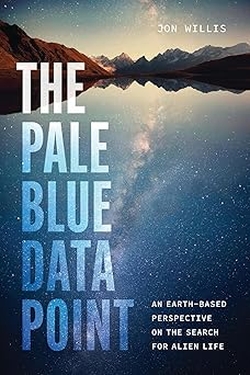Centauri Dreams
Imagining and Planning Interstellar Exploration
Spin-Orbit Alignment: A Lesson from Beta Pictoris?
I hadn’t planned to write about the recent work out of the University of Exeter on Beta Pictoris, but yesterday’s article on KELT-9b dealt with planetary alignment, given that the planet shows marked spin-orbit misalignment. At Beta Pictoris, an international team of researchers led by Exeter’s Stefan Kraus has carried out measurements of the spin-orbit alignment of Beta Pictoris b, a gas giant orbiting a young star in an orbit about as distant as Saturn from the Sun. Here we have the first spin-orbit alignment measurement of a directly imaged planetary system.
How such alignments occur is clearly relevant to planet formation theories. There’s a bit of astronomy history here, for spin-orbit issues became significant for both Immanuel Kant (1724-1804) and Pierre-Simon Laplace (1749-1827), who looked at spin-orbit alignment in our own Solar System. It was apparent to both that the planets known to them orbited the Sun not only in alignment with each other but in alignment with the Sun’s axis as well. Hence the idea that the entire system formed from a rotating planetary disc, and a flattened one at that.
Other planetary systems may follow different paths of development, as Kraus notes:
“It was a major surprise when it was found that more than a third of all close-in exoplanets orbit their host star on orbits that are misaligned with respect to the stellar equator. A few exoplanets were even found to orbit in the opposite direction than the rotation direction of the star. These observations challenge the perception of planet formation as a neat and well-ordered process taking place in a geometrically thin and co-planar disc.”
Which is to say that close-in exoplanets can depart markedly from the apparent norm, making the study of these hot Jupiters significant for initial formation scenarios. Kraus and company went to work with the GRAVITY instrument at the Very Large Telescope Interferometer (VLTI) in Chile, exploiting the fact that a star’s spectral lines show a spatial displacement — an exceedingly small one, to be sure — caused by gas absorption in the star’s atmosphere. The team used this effect to determine the orientation of the star’s rotation axis.
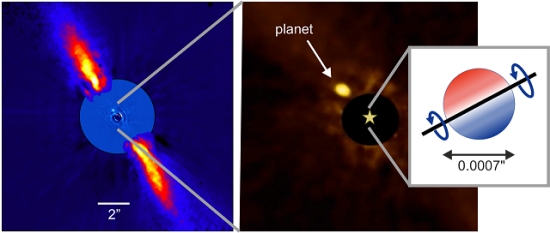
Image: The new observations show that the stellar equator (right) is aligned with the orbital plane of the planet Beta Pictoris b (middle) and the plane of the extended disc of debris material that surrounds the system (left). Credit: ESO/A.M. Lagrange; ESO/A.M. Lagrange/SPHERE consortium.
At Beta Pictoris, some 63 light years from Earth, a displacement about 1/100th the apparent diameter of the star itself is used to demonstrate that planet and star are as well-aligned as our own Solar System. Thus the classic model of planet formation seems to apply, with implications for the hot Jupiters we see that demonstrate marked spin-orbit misalignment. From the paper (internal references removed for brevity):
Our finding of spin-orbit alignment for ? Pic b suggests that this planet formed in a coplanar disks without primordial misalignments. This is in contrast to theories that describe the occurence of obliquities as a natural by-product of the star formation process, for instance through turbulent motions in the star-forming cloud and fluid-dynamical effects during disk formation. In case our finding of a well-aligned system is representative for wide-separation planets, it would suggest that the population of Hot Jupiters on oblique orbits (found in RM survey at orbit separations between ? 0.02 and 0.3 au) are likely transferred to oblique orbits through dynamical processes post-formation. Possible mechanisms include planet-planet scattering, stellar flybys, or the Kozai-Lidov mechanism, where a wide companion orbiting a close binary on a highly inclined orbit can induce oscillations in inclination/eccentricity of the close pair.
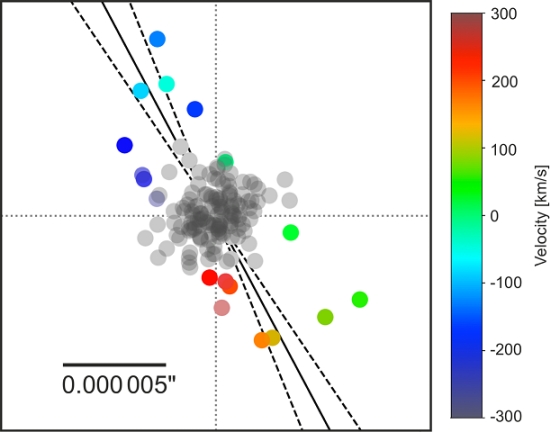
Image: To derive the stellar rotation axis of Beta Pictoris the team used the unique high angular and high spectral resolution mode of VLTI/GRAVITY to measure shifts in the centroid position in the hydrogen Brackett-gamma absorption line on micro-arcsecond scales. In the blue-shifted part of the absorption line, the centroid of the emission is displaced to the North-East, which indicates that the South-Western hemisphere of the star is approaching the observer. Credit: Kraus et al. / University of Exeter.
Much depends on just how representative Beta Pictoris b really is of gas giants with wide separation from their star. The authors propose a new high-spectral resolution interferometric instrument at the VLTI to measure the spin-orbit alignment of hundreds of gas giants, dramatically increasing the data on long-period planets. Kraus is involved in a proposed VLTI
visitor instrument called BIFROST that could enable such an observing campaign. This, in turn, should stoke the discussion of planet formation and system evolution when it comes to architectures as extreme as the one we see at KELT-9.
The paper is Kraus et al., “Spin-Orbit Alignment of the ? Pictoris Planetary System,” Astrophysical Journal Letters, Vol. 897, No. 1 (29 June 2020). Abstract / Preprint.

Building the Psyche Asteroid Explorer
If all goes well (an often perilous assumption, as JWST so frequently reminds us), NASA’s Psyche mission to the intriguing asteroid of the same name will lift off in about two years. We’re now moving out of the design and planning stage into manufacturing the spacecraft hardware, this following a period of testing on the core engineering models that will deliver the spacecraft to its target in the main asteroid belt. The critical design review, a shakeout of the three science instruments and engineering subsystems, has just been passed with flying colors.

Principal investigator Lindy Elkins-Tanton (Arizona State University) calls the process “one of the most intense reviews a mission goes through in its entire life cycle.” True enough, as everything from telecommunications, power and propulsion must pass the test, not to mention the flight avionics and computing systems. We’re a long way past the digital blueprint stage, having followed it up with prototypes and engineering models of the science instruments and engineering subsystems, all performed before the flight hardware could be built.
“This is planning on steroids” said Elkins-Tanton. “And it includes trying to understand down to seven or eight levels of detail exactly how everything on the spacecraft has to work together to ensure we can measure our science, gather our data and send all the data back to Earth. The complexity is mind-boggling.”
So what’s next? Assembling and testing of the full spacecraft is to begin in February of 2021, with a deadline of April 2021 for each instrument to be delivered to the main clean room at the Jet Propulsion Laboratory. This is going to be a fascinating mission to watch from the technology standpoint, as it will involve a demonstration of the Deep Space Optical Communications system (DSOC), intended to improve communications performance by 10 to 100 times without corresponding increases in mass, volume or power.
We’re going to want to follow DSOC closely because of its deep space implications. The plan is to deploy advanced lasers in the near infrared, and a look through NASA materials on the project shows three technologies — a low-mass spacecraft pointing assembly; a flight laser transmitter; and a pair of photon-counting detector arrays — being integrated into the DSOC system, communicating with a ground-based receiver to enable efficient communications. All this by way of exploring a future that will one day demand high-definition imagery, live video feeds and real-time data transmission for long-duration missions to deep space.
So while it’s a demonstrator, DSOC is an important one, and the Psyche mission offers a test of the system’s ability to cull faint laser signals out of a noisy background. Beyond DSOC, engineers at Maxar Technologies in Palo Alto (CA) are building the main body of the spacecraft (the Solar Electric Propulsion Chassis), attaching propulsion tanks enroute to delivery early next year to JPL, followed not long after by the solar arrays critical to power the spacecraft’s systems.
The avionics subsystem is being built at JPL, where Psyche Project Manager Henry Stone notes:
“One of the things we pride ourselves on in these deep-space missions is the reliability of the hardware. The integrated system is so sophisticated that comprehensive testing is critical. You do robustness tests, stress tests, as much testing as you can – over and above. You want to expose and correct every problem and bug now. Because after launch, you cannot go fix the hardware.”
Imagine having a job where you can talk about your involvement in multiple deep space missions, the kind of thing that makes me wish for a quick rejuvenation and a new career doing exactly that at places like JPL. And then to watch the mission fly… Psyche is to launch in August of 2022, with a Mars gravity assist in May of 2023 and arrival at Psyche in 2026.
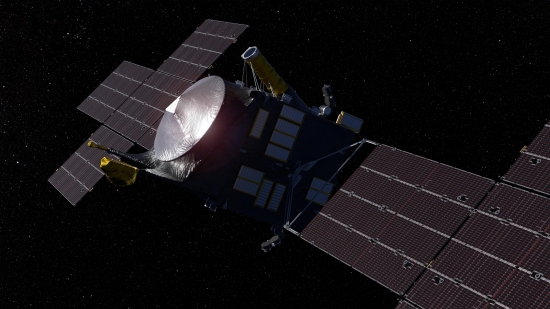
Image: This artist’s concept, updated as of June 2020, depicts NASA’s Psyche spacecraft. Set to launch in August 2022, the Psyche mission will explore a metal-rich asteroid of the same name that lies in the main asteroid belt between Mars and Jupiter. The spacecraft will arrive in early 2026 and orbit the asteroid for nearly two years to investigate its composition. Credit: NASA/JPL-Caltech/ASU/Peter Rubin.
What an interesting destination we’re dealing with. Psyche is made up mostly of iron and nickel, making it much like Earth’s core, so we may be looking at the stripped core of a differentiated planetesimal, unless the asteroid formed as a body rich in iron. If its mantle was stripped away, when did that occur, and how? Exactly how will this asteroid compare to known stony, icy objects we’ve visited? We can’t see planetary cores, but Psyche may give us a look into a planetesimal core from the era of collisions and accretion that produced the terrestrial planets.
The spacecraft will fly with a magnetometer to measure the asteroid’s magnetic field, along with a multispectral imager to collect images and data about the object’s composition and topography. Spectrometers will analyze the surface to determine its chemical abundances. The propulsion system is an electric hall thruster using xenon as the propellant. ATLO is next — Assembly, Test and Launch Operations — all beginning in February of next year. Love those NASA acronyms!

KELT-9b: ‘Gravity Darkening’ and an Asymmetric Light Curve
Perhaps the hottest planet ever discovered spotlights yet another way to interpret light curves produced by transiting worlds. KELT-9b comes out of data gathered by the KELT transit survey, the acronym standing for Kilodegree Extremely Little Telescope. KELT consists of two robotic telescopes, one at Winer Observatory in southeastern Arizona, the other at the South African Astronomical Observatory in Sutherland, South Africa. The planet orbits an A-class star in Cygnus about 670 light years away and turned up in the KELT data in 2017.
We’ve learned a lot more about KELT-9b thanks to the TESS mission, allowing us to understand just how unusual this planet is. 2.9 times as massive as Jupiter, the world orbits its star in 36 hours, receiving 44,000 times the energy from its host that Earth receives from the Sun. Reaching 4,300 degrees Celsius, this is a tidally locked planet whose dayside is hotter than the surfaces of some stars. Its orbital path takes it almost directly above both the star’s poles.
But this mix gets even more intriguing. The primary, KELT-9, is roughly twice the size of the Sun, 56 percent hotter, and spins 38 times as fast. That makes for a complete stellar rotation in 16 hours. As you would imagine, the rapid spin causes the star to deform, flattening at the poles and broadening at the equator. As a result, we run into the phenomenon known as gravity darkening — the poles brighten as the equatorial region cools and dims by comparison.
We get a temperature differential of almost 800 degrees Celsius. The effects on the transit light curve are interesting. Beginning near the star’s poles, the transit blocks less light as KELT-9b travels over the stellar equator. We have an asymmetry here we can work with to gain information about the temperature and brightness changes over the surface of the star, learning more about its shape and orientation.
Jason Barnes (University of Idaho) is a co-author of the paper on this work:
“Of the planetary systems that we’ve studied via gravity darkening, the effects on KELT-9 b are by far the most spectacular. This work goes a long way toward unifying gravity darkening with other techniques that measure planetary alignment, which in the end we hope will tease out secrets about the formation and evolutionary history of planets around high-mass stars.”
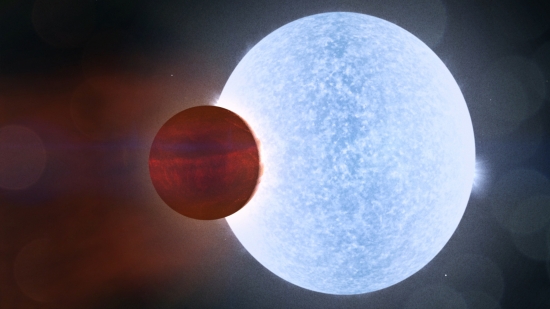
Image: Observations from NASA’s Transiting Exoplanet Survey Satellite (TESS) have revealed new details about KELT-9b’s environment. The planet follows a close, polar orbit around a squashed star with different surface temperatures, factors that make peculiar seasons for KELT-9b. The planet’s transits begin near one of the star’s hot, bright poles and progress toward the cooler, dimmer equator. Credit: NASA’s Goddard Space Flight Center.
Depending on which part of the star is being referenced, the phenomenon behind gravity darkening is sometimes called gravity brightening, reflecting the fact that the oblate shape of such a rapidly spinning star causes higher surface gravity at the poles, producing higher temperature and brightness; by contrast, the equator is darker. Because of the temperature differential on the surface of the star, KELT-9b experiences an unusual kind of seasonality, hotter over the poles, colder over the star’s equator. A kind of summer, a kind of winter, with each season lasting nine hours, only to repeat during the brief year.
A planet like this is going to be useful for research into hot Jupiters. There is a clear trend among such worlds in that they are often spin-orbit misaligned. The paper continues:
“Its high dayside temperature provides excellent opportunities for phase curve and secondary eclipse analyses (Hooton et al. 2018; Wong et al. 2019; Mansfield et al. 2020). The high signal-to-noise ratio of its transit makes KELT-9 b a top target for transmission spectroscopy (Hoeijmakers et al. 2018, 2019; Cauley et al. 2019). In this work, we model KELT-9 b’s Transiting Exoplanet Survey Satellite (TESS) light curve including rapid stellar rotation to measure the hot Jupiter’s transit parameters, and we take advantage of the transit asymmetry caused by gravity darkening to robustly constrain the planet’s orbital geometry including its true spin–orbit orientation.
Thus this paper is unusual in being one of the few that deal with gravity darkening in analyzing an exoplanet lightcurve. Using it, the authors measure the planet’s alignment angle and discuss the effects of gravity darkening on the hot Jupiter’s atmospheric processes. In the figure below, the effects of gravity darkening are apparent in the transit.
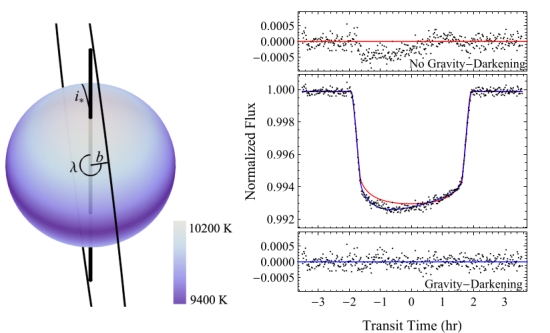
Image: This is Figure 2 from the paper. Caption: (Left) KELT-9 b begins its transit near the star’s hot pole and moves toward the star’s cooler equator. Our transit analysis directly measures the stellar inclination ( i ), the planet’s projected alignment (?), and the orbital inclination (i.e., the impact parameter b). We find that KELT-9 varies in effective temperature by ?800 K between its hot poles and cooler equator. (Right) KELT-9 b’s phase-folded primary transit from TESS. The transit depth steadily decreases throughout the eclipse, indicating that KELT-9 b begins its transit near one of the host star’s hotter poles and moves toward the dimmer stellar equator. Credit: Ahlers et al.
Models of rapidly rotating stars are still being developed, but will be needed to analyze the high number of such stars expected to be discovered by TESS. In fact, I was surprised to learn that in a previous paper, lead author John Ahlers (NASA GSFC) had estimated on the order of 2,000 exoplanets will turn up orbiting A/F stars in the TESS data, and the expectation is that a large number of these will be spin-orbit misaligned. Thus KELT-9b gives us a window into fast rotators, which are expected to comprise a large number of the A/F systems discovered.
The paper is Ahlers et al., “KELT-9 b’s Asymmetric TESS Transit Caused by Rapid Stellar Rotation and Spin–Orbit Misalignment,” The Astronomical Journal Vol. 160, No. 1 (5 June 2020). Abstract.

A SETI Reality Check
Given how much we do not know about everything from abiogenesis to the lifetime of technological civilizations, what can we say about SETI’s chances for success? Henry Cordova, a Centauri Dreams regular, is a long-time SETI enthusiast who has nonetheless been revising his thinking on the discipline’s prospects. Our one useful sample, Earth, tells us how long it took for life just to become multi-cellular, much less to reach the tiny window opened by our technological society. And need we assume that intelligence will inevitably arise even with complex biology to support it? A retired geographer and mapmaker currently living in southeast Florida, Henry served in the US Navy and was originally trained as an astronomer and mathematician. Amateur astronomy, celestial navigation and collecting star atlases occupy his time when he’s not pondering questions like how civilization might arise without technology, or whether Dysonian strategies — looking not for beacons but evidence in the form of engineering suggested by anomalies in our data — may or may not be the best way for SETI to proceed. One thing’s for sure: The questions SETI raises offer many solutions, not all of which lead to contact.
by Henry Cordova

The last few years have been kind to SETI enthusiasts. As hard scientific facts continue to accumulate, the factors in the Drake equation seem a little less unknowable and the evidence, although circumstantial, is starting to look very compelling. We know now that the molecular clouds where solar systems form are seeded with the chemical precursors to life and with the comets and meteoroids which can transfer this chemistry to planetary surfaces. The detection of organic compounds in meteorites and in the spectra of celestial bodies, as well as the serious proposal of fossils of Martian microbes, all argue that science is comfortable with the idea that life arises spontaneously wherever conditions are favorable. Our planet’s own geological history corroborates this; it appears that life began here almost as soon as the primitive Earth cooled. The non-photosynthetic food chains found in submarine vents and the recent discovery of deep crustal microbial communities have made scientists comfortable with speculation of life on Europa and other solar system sites. It now seems likely that life can gain a foothold in any suitable environment and will arise spontaneously in many places throughout the universe.
We may add to this evidence the results of one of the more mature branches of astronomy: stellar structure and evolution. Stable and long-lived stars suitable for nurturing life seem to be the rule, not the exception, and planets are probably a normal by-product of the formation of these systems. The recent detection of many extrasolar planets, albeit non-earthlike, suggests our own solar system is not unique. All the evidence is not in, but it is not unreasonable to assume that life is quite common in the Galaxy. Our own planet’s past supports the conclusion that living worlds are self-regulating and quite capable of surviving all but the most devastating of cosmic catastrophes. The combined speculations of astronomy, geology, and biology are in agreement that SETI is on the right track. In my opinion, there are tens of millions of life-bearing worlds at this moment in our galaxy, give or take an order of magnitude.
And now, the bad news… The evidence for extraterrestrial intelligence, that is, extrasolar species capable of constructing communications devices, is totally non-existent. We have very little to go on other than our own example. The Earth has been the abode of life for at least 3 billion years, but for most of that time it was represented by only the most primitive micro-organisms. For a substantial portion of Earth’s history life consisted solely of anaerobic microbes. The development of photosynthesis appears to be a bottleneck in evolution, but not as severe as the appearance of multi-cellular organisms, which did not appear until about half a billion years ago. If this pattern is not peculiar to Earth and is typical of life-bearing worlds, the consequences for SETI are troubling.
SETI requires reasonably complex and active life forms as participants–on both sides. We must expect that candidate species share an oxygen metabolism and a multicellular architecture comparable to vertebrates in sophistication. We know that intelligent primates, and possibly intelligent cetaceans, appeared on Earth only a half-billion years after the first appearance of multicellular creatures, a relatively short time by astronomical standards. But we should not conclude that intelligence was inevitable, simply awaiting a mammalian nervous system of sufficient capacity to support it. Mammals have been around for as long as the reptiles and have spent most of this time without developing any technical abilities. The dinosaurs and birds never chose intelligence as a strategy, and the cetaceans prove that even intelligence does not necessarily lead to tool-making. Primate cooperative technical intelligence, aided by language, arose only a heartbeat ago in the cosmic time scale. Its late arrival and explosive growth suggests it was not inevitable, and probably accidental. We cannot even conclude from this history that intelligence is a survival trait; it is possible that its very advantage to a species is destabilizing to the biosphere as a whole. I shall omit at this point the usual cautionary remarks about nuclear war and environmental pollution… Neither should we forget that highly advanced civilizations need not necessarily be technological, even if they start out that way.
If we determine that technical societies capable of interstellar communication are common and not prone to self-destruction; it is still not obvious that they will be eager to communicate with us. Many will be cautious about talking to strangers and choose only to listen, others may tire of SETI after the first success–just as I suspect we will, as much as I hate to admit it! In fact, the more likely a culture is to engage in SETI, the more likely that it already has all the correspondents it wants. Once a SETI-prone species makes contact, it may prefer to cancel expensive searches using energy-inefficient methods and concentrate on upgrading its existing communications and refining its technologies. In other words, if CETI is common and widespread in the Galaxy, newcomers will probably not be sought out very aggressively.
The limiting factor in interstellar communication is not distance, but time. Even neighboring civilizations might be highly separated in time, time also affects the conduct of individual contacts. Centuries have to pass before each transmission’s success can even be evaluated. If we assume that during the course of its existence the Galaxy has hosted a million technical societies, and each of them survived an average of a million years, at any one time we could expect only a hundred active cultures in the entire Galaxy–about one for every billion stars. These numbers are not very encouraging, the average age of a civilization is one of the big teasers in the Drake Equation. For ETIs to be common enough to find easily this value has to be inordinately high. It seems inescapable that even if civilizations are very common, at any one time they are few and far between.
It is risky to make predictions about ETIs, but let’s try a few very liberal assumptions in order to further explore some issues in SETI targeting. Assume that there are a million species in the Galaxy right now capable of and interested in communicating with their neighbors using microwave or laser technology (the only ways we know how!). With about a hundred billion stars in the Galaxy, this works out to about one civilization for every hundred thousand stars. The stellar density in the solar neighborhood is such that there are approximately that many stars within two hundred light-years of Earth. This line of reasoning suggests that civilizations are at least several hundred light-years apart and that for them to have the slightest chance of contacting their neighbors they must be prepared to transmit (and listen) to hundreds of thousands of stars for millions of years just to have a fighting chance of making a one-way contact. Even if our hypothetical ETI is capable of using advanced astronomical techniques to eliminate unsuitable stars, the magnitude of this task is enormous.
Any society contemplating a passive search for the first time (like us) must hope that its neighbors have been carefully tracking thousands of targets and transmitting continuously at them for millions of years in order to have even the remotest statistical chance of intercepting a signal. Passive SETI is easy, but it depends primarily on what the other guy is doing. If the passive party further expects the active member to be transmitting at him in a narrow, energy-efficient beam, and has designed its listening strategy accordingly, in my opinion, they are wasting their time and squandering their budget.
Most SETI passive strategies are based on high signal-to-noise ratio directed searches of nearby stars, selected for their high probability of harboring intelligent life (old and stable Pop I disc stars on the main sequence). But as we have demonstrated, even a perfectly suitable world is highly unlikely to be transmitting at us when we look at it. To have a good chance of intercepting a signal, we must simultaneously observe large numbers of stars, i.e., large volumes of space. The active partner will also realize this, and will know that transmitting directly at nearby sunlike stars on narrow beams will be energy-efficient but highly ineffective. To listen (or transmit) using narrow “spotlight” methods allows weak signals to be heard or sent immense distances, but does little to maximize the number of stars reached. A “floodlight” or broadcast approach will saturate small volumes of space with signal, but is very wasteful and reaches few stars for the energy expended.
I suspect advanced SETI species will adopt an intermediate “searchlight” methodology where a wide beam, on the order of a radian in diameter, will be aimed at regions where large numbers of stars are found. I envision active transmitters to be aimed at the galactic plane, the signal footprint wide enough to encompass the thickness of the entire Milky Way and nearby disk stars. The best way to listen for these signals would be to concentrate on wide areas near the galactic equator, and to worry about the location where the signal originates only after it has been detected. Design receivers for sensitivity, not resolution. In other words, sweep the galactic plane first, particularly in areas of high galactic longitude. ETI will most likely be transmitting towards the nucleus, the direction where most of the old stars are. Those civilizations at low galactic longitudes might even be transmitting across our line of sight, towards the galactic center, and we would not be able to hear them at all.
We have just recently learned, in cosmic terms, how to conduct SETI. At present, we cannot develop the antenna power to transmit a searchlight signal that would stick out above the noise for more than a few light years. We can only hope that others have been at this a lot longer than we have and will be able to do so.
The remarks above apply to the traditional thinking on SETI that has been the operational paradigm since the introduction of radio astronomy. The only way we know to make our presence known across galactic distances is with electromagnetic radiation, radio, or possibly, laser signalling devices. This may not necessarily be the case, but we have little choice but to proceed as if it were. We are forced to conclude that the only way to find ET is with physics-based technology similar to our own.
But what if there may be highly advanced civilizations with no technology at all? I suspect that high degrees of sophistication and culture are possible with no technology whatsoever. This may be no surprise to anyone reading this, but has the consequent reduction of the statistical probability of communicating civilizations sunk in to the average SETI enthusiast?
I must confess it has become apparent to me only lately. As you get older, you get wiser. Not necessarily smarter, but wiser.
And what about technical civilizations whose development proceeded among lines very different from ours? A cetacean-like creature may have evolved along acoustic lines, not mechanical or electro-magnetic. A commensal colonial organism might have concentrated on genetic technologies, breeding living organisms for practical use, rather than building machines. Some societies may have highly advanced chemistry based on biological concepts, rather than in vitro tech. Alien civilizations may not even be recognizable to our eyes as civilizations; we may only see them as complex ecosystems, rain forests or coral reefs (Gaia and Solaris-type entities come to mind) than as communities. Some civilizations may have evolved on permanently cloudy worlds, or under water, or in water under ice under clouds.
Even if we could realize them for what they are, they may be operating on vastly different timescales than we do. Those of us who read science fiction no doubt are familiar with these possibilities, but do we ever really consider how that rarest of cosmic accidents, the intelligent alien species, is made even rarer still by the fact maybe they never discovered fire, electricity, glass, metals? No matter how many of them there are, if they can’t build radio telescopes or spacecraft, how will they find us? How will we even recognize them if we find them first?
And of course, there is always the possibility they will have long ago stumbled onto technologies that make radio telescopes and spacecraft unnecessary. Broadcasting microwaves at nearby stars may be like Amazonian tribesmen trying to signal jet contrails by beating drums or lighting fires. There are lots of things allowed by nature that we do not know about, that perhaps we will never know about.
Indirect evidence suggests that SETI-capable civilizations will be highly separated in space and even more so in time. There may be a much smaller probability than previously thought to make contact with these cultures. In order to maximize this probability, we may have to rely on search strategies which are counter-intuitive. We can only hope that these civilizations will also anticipate these conditions and modify their procedures accordingly. I wish to go on record as saying that conducting passive searches for alien communications is a waste of resources. The aliens have probably realized this and are not actively signalling us anyway. Although I hesitate to suggest that any form of research be discouraged, perhaps our resources could be directed in other, more productive directions. At the very least, our searches could be piggybacked onto other research programs with a higher probability of success. It is also worthwhile to seek evidence of extraterrestrial industrial activities; navigational beacons, planetary defense radars, weapons testing, industrial accidents, experimental or accidental energy releases, or perhaps even deliberate attempts to make their presence known, such as the dumping of short-lived radio-isotopes into the local sun. It might not be worthwhile to search specifically for such speculative events, but they might very well turn up in the course of other investigations.
It may be a long time before we make contact, perhaps never. We are almost certainly not alone, but we may never be able to know for sure.

Tracking a Jovian Outbreak
Another win for amateur astronomers. Have a look at a Juno image showing the familiar Great Red Spot (upper left) and a new, bright spot just emerging in the center of the image, an oval-shaped feature that was not present in images taken not long before by astronomers in Australia. We’re looking at a plume erupting into the upper layers of the atmosphere, a convective outbreak in a region known as the South Temperate Belt, a latitude where outbreaks are not uncommon.
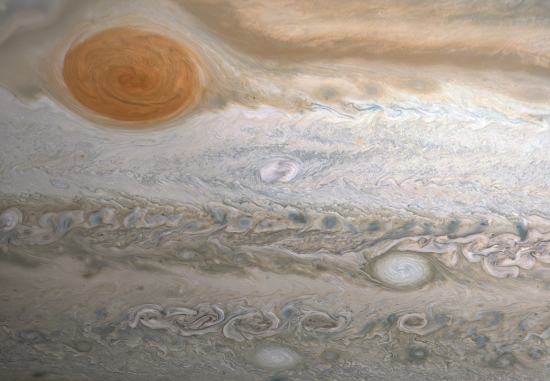
Image: Juno’s view of the swath of Jupiter visible from its recent flyby. Credit: NASA/JPL-Caltech/SwRI/MSSS. Image processing by Kevin M. Gill.
The Juno image, taken on June 2, 2020, is fortuitous, because it was just two days before that South African amateur Clyde Foster (who is director of the Shallow Sky section of the Astronomical Society of Southern Africa) discovered the new spot while working with a filter sensitive to wavelengths where there is strong methane absorption in Jupiter’s atmosphere. Juno happened to be in the midst of its 27th close flyby of the giant planet, and while the craft would not pass directly over the outbreak, the science team realized it was close enough to view the young feature.
Credit goes to another amateur, Kevin M. Gill, for work on the Juno image using data from the spacecraft’s JunoCam. The view is a map projection combining five JunoCam images, taken when the spacecraft was between 45,000 kilometers and 95,000 kilometers from the cloud tops, moving over latitudes between 48 degrees and 67 degrees. For those of you with a yen to manipulate such imagery, the JunoCam raw images can be accessed here.
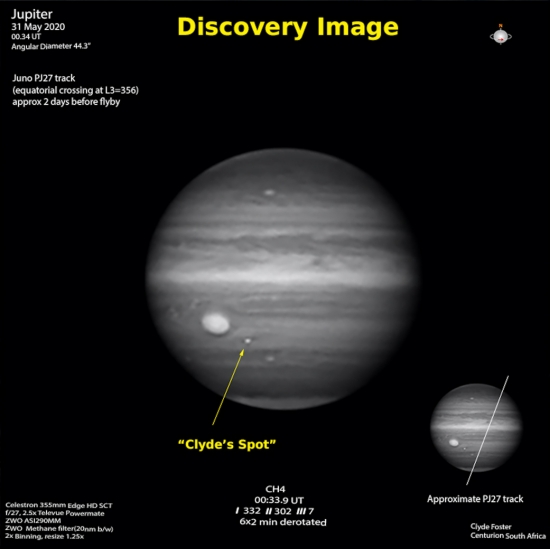
Image: The discovery image, with Juno’s north-to-south trajectory superimposed at bottom right. Nice work with Foster’s Celestron!

An Exposed Planetary Core at TOI-849
In exoplanet research, ‘deserts’ are regions where things are not found. Thus the Neptunian Desert, which is a zone close to a star where planets of Neptune size only rarely appear. Deserts like this (there is also a Brown Dwarf Desert that we’ve examined in earlier posts) raise questions because we don’t know why they occur. What is it we don’t understand about planet formation that accounts for the lack of Neptune-mass planets in 2-4 day orbits?
Exceptions tweak our thinking, and do have NGTS-4b, a world 20 percent smaller than Neptune and 20 times as massive as Earth in a 1.3-day orbit around a K-dwarf (see Into the Neptunian Desert for more on this one, which is now joined by an even more puzzling object).
For today we learn of the discovery of a world of roughly Neptune’s mass with an orbital period of a scant 18 hours, and researchers reporting the discovery in Nature suggest that we are actually looking at a ‘failed’ gas giant, an exposed planetary core. We can thank TESS (Transiting Exoplanet Survey Satellite) for the original data on this one, which is labeled TOI 849b. The object orbits a star much like our own about 730 light years from the Sun.
Follow-up observations with the HARPS spectrograph at ESO’s La Silla Observatory in Chile complement the TESS transit data with the radial velocity readings used to determine that the object is two to three times more massive than Neptune but also incredibly dense. It must, then, consist largely of iron, rock and water, with little hydrogen and helium. Physicist David Armstrong (University of Warwick), lead author of the paper on this work, describes the first intact exposed core of a gas giant found around a star:
“While this is an unusually massive planet, it’s a long way from the most massive we know. But it is the most massive we know for its size, and extremely dense for something the size of Neptune, which tells us this planet has a very unusual history. The fact that it’s in a strange location for its mass also helps — we don’t see planets with this mass at these short orbital periods. TOI 849 b is the most massive terrestrial planet — that has an Earth like density — discovered. We would expect a planet this massive to have accreted large quantities of hydrogen and helium when it formed, growing into something similar to Jupiter. The fact that we don’t see those gases lets us know this is an exposed planetary core.”

Image: Artist’s impression showing a Neptune-sized planet in the Neptunian desert. It is extremely rare to find an object of this size and density so close to its star. Credit: University of Warwick/Mark Garlick.
So is this really a ‘failed’ gas giant, or a gas giant that formed normally and then lost its gas envelope? If the latter, we could be looking at tidal disruption from the objects’ tight orbit, or even a collision with another planet. Photoevaporation of the atmosphere due to its position near the star is a contributing factor, but not one that fully accounts for the loss of gas.
If a failed gas giant, then in TOI 849 we would be looking at a world that never formed an atmosphere in the first place, with implications for the original protoplanetary disk. Christoph Mordasini (University of Bern) led the theoretical analysis of the discovery:
“Once the core of the gas giant formed then something very unusual could have happened and it never formed a massive atmosphere as normally. This could have occurred if there was a gap in the disk of dust and gas that the planet formed from due to gravitational interaction with the planet, or if the disk ran out of material right at the very moment when gas accretion normally follows.”
Thus the possible formation and evolution of TOI-849b, as shown below.
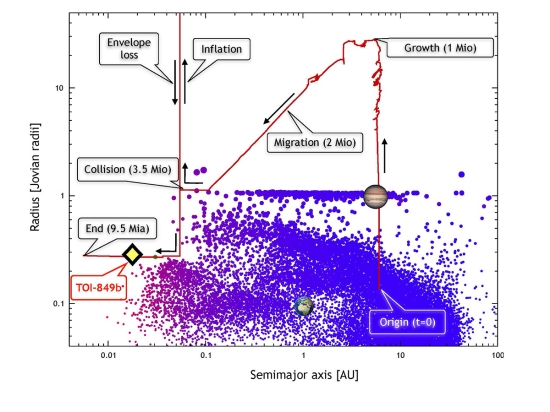
Image: The red line shows the evolutionary track of a simulated planet that finally has similar properties as the actual planet TOI-849b, as found in the Bern Model of planet formation and evolution. The track is shown in the plane of semimajor axis in astronomical units (AU), that is the orbital distance from the star, on the x-axis, and the radius of the planet in units of jovian radii on the y-axis. The blue-red points show other planets predicted by the model. The Earth and Jupiter are shown at their positions for comparison. The planet starts to form at the initial time t=0 years as a small planetary embryo at about 6 AU. The protoplanet grows in mass in the following 1 million year which increases its radius. In this phase, the radius of the planet is still very large, as it is embedded in the protoplanetary disk in which it forms. The increasing mass of the protoplanet causes it to migrate inwards, towards the star. This reduces again the size of the planet. After 3.5 million years, the planet has migrated to the inner edge of the disk.
There, it suffers a very energetic giant impact with another protoplanet in its planetary system. The enormous heat liberated in the collision strongly inflates the gaseous envelope of the planet. The envelope is lost via Roche-lobe overflow, and an exposed planetary core comes into existence. In the following billions of years, the exposed core slowly spirals towards its host star because of tidal interactions. The simulate planet now has properties like a mass, radius, and orbital distance which are very similar the observed properties of TOI-849b that is shown by a black-yellow symbol. In the end, after about 9.5 billion years, the planet falls into its host star. Credit: © Universität Bern / Christoph Mordasini / Physikalisches Institut, Weltraumforschung und Planetologie.
Whether a failed gas giant or a disrupted one, TOI-849b represents an exposed core, something we don’t see in our own Solar System, and it may provide insights into the interior of planets like Jupiter. Future measurements may pick up any trace atmosphere replenished from the core, which would give us data on the chemical composition of the intriguing object.
The paper is Armstrong et al., “A Remnant Planetary Core in the Hot-Neptune Desert,” Nature 1 July 2020 (abstract).

